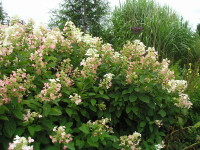A true appreciation of shrubs is a sign of maturity in any gardener. They are so much more than the predictable assortment of evergreens seen around house after house: dull, deplorable and completely uninspired, what most homeowners (and landscapers) consider “landscaping”.

Hydrangea paniculata ‘Pink Diamond’ has more delicate flowers than the more commonly planted “Peegee” (paniculata ‘Grandiflora’) The trusses open pure white but mature to a rich pink by autumn.
On the contrary, one could make a rich, beautiful and deeply satisfying garden entirely of shrubs. There is so much variety in form, texture, color, bloom, habit… and they give so much for wanting so little.
More than any other class of plant, shrubs are problem solvers. Need to screen the neighbors? Plant shrubs. Want lower mainteance? Plant shrubs. Envision cutting armloads of flowers and foliage for indoor arrangements? Shrubs again. Like trees, they need be planted only once, and when established will give a lifetime of beauty and enjoyment. If chosen properly for your situation, most shrubs are relatively easy to grow, need minimal fertilization, very little pruning, little or no pest control. Shrubs just carry on, giving satisfaction year after year.

Evergreen shrubs, such as this Juniperus chinensis, provide structure and soothing greenery all year long.
Technically speaking, a shrub is a woody plant that usually grows with several or many stems emerging from the ground, as opposed to a tree, with a single trunk. Many shrubs also send up new growth from the base every year (think Lilacs). But the distinction is not set in stone; some trees may sucker and have multiple trunks, while shrubs may grow from a single point only, or be trained to do so. “Tree Hydrangeas” and “Tree Roses” are actually just shrubs that have been pruned and trained into a single stem with a large bushy top. The proper horticultural term for this is a “standard”.

The viburnums are an enormous genus with many garden-worthy cultivars, like this Viburnum dilatatum ‘Cardinal Candy’. The fruit is preceded by foamy white flowers.
Which brings us back to the point that shrubs are so adaptable and useful, such workhorses in the landscape whether used formally or naturalistically. Shrubs can provide beauty and interest every month of the year from foliage, flower, fruit, fall color and winter structure. They are indispensable, easygoing, and richly rewarding plants.


